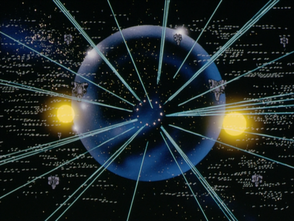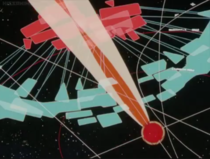Sixth Battle of Iserlohn
From Gineipaedia, the Legend of Galactic Heroes wiki
This article is about the Alliance–Imperial War battle. For the Gaiden episode of A Hundred Billion Stars, A Hundred Billion Lights, see The Sixth Battle of Iserlohn (episode).
| Sixth Battle of Iserlohn | |||||
| (Alliance–Imperial War) | |||||
 The Alliance opening salvo against Iserlohn | |||||
| Date: | 1–10 December 794 UC (485 IC / 3594 CE) | ||||
| Location: | Iserlohn Fortress | ||||
| Result: | Imperial victory | ||||
| |||||
| |||||
| |||||
| |||||
The Sixth Battle of Iserlohn (Japanese: 第6次イゼルローン攻防戦) in early December 794 UC (485 IC / 3594 CE) was the sixth military offensive launched by the Free Planets Alliance against the Galactic Empire's front-line stronghold, Iserlohn Fortress. The engagement was mostly strategically insignificant, as was typical of many battles in the later stages of the Alliance–Imperial War, but became well known for its noticeable involvement of younger officers in their twenties and thirties who went on to play prominent roles in galactic history a few years later.
These included the fleet commander Rear Admiral Reinhard von Lohengramm (then von Müsel), squadron commanders Oskar von Reuenthal and Wolfgang Mittermeyer, battleship captain Fritz Joseph Bittenfeld, and ace pilot Karl Gustav Kempf. On the Alliance side, too, young officers saw action, including operations staff officer Yang Wen-li, destroyer captain Dusty Attenborough, logistics officer Alex Cazerne, infantry commander Walter von Schönkopf, and ace pilots Ivan Konev and Oliver Poplin.
Contents |
Background
In September 794 UC (485 IC / 3594 CE), it became known that the Free Planets Alliance would launch another offensive against Iserlohn Fortress. The operational plan was basically to lure the Imperial fleet out of the fortress by attacking from the limit of the Thor Hammer's firing range, and then sending missile cruisers around the periphery of the Iserlohn Corridor to break open Iserlohn's walls with their firepower. This was the plan proposed by Vice Admiral Willem Holland, and was accepted by Fleet Admiral Lassalle Lobos, Alliance Space Fleet Commander-in-Chief, because he found out that a General Staff Officer, Commander Andrew Falk, proposed a similar plan. Lobos valued Falk's opinion highly and decided to accept Holland's proposal (which was called "Operation Waltz on D-Line") because of Falk's endorsement. The plan was not enthusiastically received by the other officers on Lobos's command staff, however, and was notably criticized by Captain Yang Wen-li, then an Operations Staff Officer serving with Fleet Headquarters. (HBSHBL: 'Truth Is the Daughter of Time')
Rear Admiral Reinhard von Müsel's squadron arrived at Iserlohn as part of the additional units deployed there in order to counter the expected Alliance attack. Reinhard, like Yang, also criticized the fixation of both sides on Iserlohn Fortress. During November, he subsequently took part in multiple skirmishes throughout the Corridor against Alliance vanguard units probing Imperial defenses, and managed to give them considerable losses through his tactics. Reinhard used the opportunity as a way to test different battlefield tactics against small units of enemy ships. Most notably, he destroyed a force under Rear Admiral Ramsay Wartz, whose chief of staff was a former classmate of Yang's at the Alliance Command Academy and considered a genius, Captain Malcolm Wideborn. Wideborn advised his commander to fan out his ships in order to envelop Reinhard's squadron, only for Reinhard to then charge at the weakened center with full force and destroy Wartz's flagship. Both Wartz and Wideborn were killed. Later on, while trying a manuever to attack the enemy from the rear, Reinhard was nearly surrounded by Alliance ships following Captain Yang's advice, and only managed to escape with significant losses by breaking out at the weakest point of the encirclement. (HBSHBL: 'Truth Is the Daughter of Time')
By late November 794 UC (485 IC / 3594 CE) the Free Planets Star Fleet had completed its deployment in the Corridor and had moved in towards Iserlohn Fortress, beginning the Sixth Battle of Iserlohn. (HBSHBL: 'Truth Is the Daughter of Time')
Order of battle
Alliance
- The HQ Fleet, Fleet Admiral Lassalle Lobos
- The missile detachment, Rear Admiral Willem Holland
In total the Alliance mobilized some 30,000 ships.
Imperial
- The Iserlohn main fleet, Admiral Willibald Joachim von Merkatz
- The Müsel Fleet, Rear Admiral Reinhard von Müsel
The Imperial forces at Iserlohn numbered some 20,000 ships.
The battle

The Alliance Fleet attacked Iserlohn Fortress on 1 December 794 UC (485 IC / 3594 CE), remaining out of range of the Thor Hammer as planned and forcing the Imperial commander, Fleet Admiral Gregor von Mückenberger to deploy the stationed fleet and engage them from a distance. At that point, the Alliance initiated the second phase of the plan and deployed a squadron under Rear Admiral Holland to assault the fortress walls. Initially they made a breach by attacking from a dead angle where the main fleet and turrets could not reach them, but were then decimated by an Imperial reserve unit of 2200 ships, commanded by Rear Admiral von Müsel. His forces prevented Holland from carrying out his plan, and after the missile cruisers were destroyed Reinhard moved on to attack the main Alliance fleet from an odd angle—between the edge of the navigable explored space of the Corridor and the Thor Hammer's range—that prevented them from utilizing the full strength of their superior numbers against Reinhard's squadron. (HBSHBL: 'The Sixth Battle of Iserlohn')
Meanwhile, the Alliance's elite Rosen Ritter infantry regiment of Imperial exiles took over a number of Imperial vessels and demanded that Rear Admiral Hermann von Lüneburg showed up to face them. Lüneburg defected twice, first to the Alliance and then back to the Empire, and was former commander of the Rosen Ritter. Mückenberger decided to eventually force Lüneburg to go out and answer their challenge. The current commander, Colonel Walter von Schönkopf, fought and killed their former leader in single combat on 5 December 794 UC (485 IC / 3594 CE). (HBSHBL: 'The Sixth Battle of Iserlohn')

Around that time, the battle had dissolved into a stalemate as Fleet Admiral von Mückenberger ordered the main Imperial fleet, under Admiral Willibald Joachim von Merkatz, to leave its positions around the fortress and to join Reinhard's squadron in attacking the Alliance forces. This decision rendered the Thor Hammer useless as Imperial ships blocked the superlaser's line of fire, and the battle soon turned into a chaotic stalemate when Fleet Admiral Lobos threw the Alliance's reserves into the fray as well. The squadron under Reinhard returned to Iserlohn for resupply. (HBSHBL: 'The Sixth Battle of Iserlohn')
By December 9, with the Alliance Fleet HQ largely following Captain Yang's recommendations through Lobos's chief of staff, Admiral Dwight Greenhill, the Alliance reorganized its formation and re-positioned itself, driving the disorganized Imperial forces back towards Iserlohn. In large part due to the skilled leadership of commodores Oskar von Reuenthal and Wolfgang Mittermeyer the Imperial fleet was able to regroup and maintain its position, preventing a total rout. During that time significant fighter combat also took place between Alliance Spartanians and Imperial Walküren, while the surviving missile cruisers of Rear Admiral Holland's detachment played a key role in helping inflict damage on the Imperial formation. (HBSHBL: 'A Hundred Billion Stars, One Ambition')
However, Imperial Commander-in-Chief Mückenberger accepted a proposal from Reinhard to use a small squadron of ships to lure the Alliance away temporarily and allow the main fleet to disengage, giving them the opportunity to use the Thor Hammer to decimate the Alliance forces. The ploy worked, and as Reinhard hoped, the Alliance sent units to follow his fleet, which attacked the Alliance flanks by moving within the range area of the Thor Hammer. The Alliance pursued him and as Reinhard anticipated, Admiral von Merkatz, commanding the main Imperial fleet, gave the order to disengage and withdraw. Alliance HQ ignored Yang's warnings and continued following Reinhard's squadron until they were well within range of the Thor Hammer, which then fired and inflicted a similar level of staggering Alliance losses to the ones from the previous Iserlohn battles. The Alliance Fleet HQ ultimately chose to withdraw, at 17:40, 10 December 794 UC (485 IC / 3594 CE). (HBSHBL: 'A Hundred Billion Stars, One Ambition')
Aftermath
The Alliance had lost a total of 794,600 personnel killed, while the Empire lost 368,800. Overall the Sixth Battle of Iserlohn did not prove to have much strategic significance, as many other engagements during the later stages of the Alliance–Imperial War, and was viewed by both Reinhard von Müsel and Yang Wen-li as a waste of lives. (HBSHBL: 'A Hundred Billion Stars, One Ambition', TBT: 'Part One')
For the Alliance, the defeat was a major loss as the previous battles had been, though individual commanders who were successful got promoted. Yang became a commodore, while Willem Holland became a vice admiral and was given command of the 11th Fleet, presumably for his role in commanding the missile ship detachment against the Empire during the battle. Holland's command decisions and planning would lead to another Alliance defeat as well as the decimation of the 11th Fleet at the Third Battle of Tiamat, in February 795 UC (486 IC / 3595 CE), just a few months after the sixth Iserlohn battle. (HBSHBL: 'A Hundred Billion Stars, One Ambition', TBT: 'Part One', 'Part Two')
Ultimately, the aristocratic Imperial High Command regarded their troop casualties from the battle as "low" and thus decided on another offensive later that month for next year, to commemorate the thirtieth anniversary of the coronation of Kaiser Friedrich IV. This was partly an attempt to distract the public from the lack of the emperor's domestic accomplishments, with retaliation for the Sixth Battle of Iserlohn used as the official justification. This offensive resulted in the aforementioned Third Battle of Tiamat, which fulfilled the Imperial government's desire for a propaganda victory. (HBSHBL: 'A Hundred Billion Stars, One Ambition', TBT: 'Part One', 'Part Two')
This battle was also the Alliance's final attempt to take the fortress with a large-scale offensive before the Seventh Battle of Iserlohn in 796 UC (487 IC / 3596 CE), which resulted in Yang Wen-li's 13th Fleet successfully capturing Iserlohn Fortress using subterfuge rather than brute force. (LOGH: 'Iserlohn Captured!')